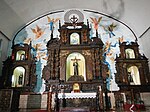Quezon Avenue

Manuel L. Quezon Avenue, more often called as Quezon Avenue, or simply Quezon Ave (pronounced: Ke-zon-Av), is a 7.1-kilometer (4.4 mi), six-to-fourteen lane, major thoroughfare in Metro Manila named after President Manuel Luis Quezon, the second president of the Philippines. The avenue starts at the Quezon Memorial Circle and runs through to the Mabuhay Rotonda near the boundary of Quezon City and Manila. It is one of the most comfortable roads in Quezon City, lined with palm trees on its center island. Many government and commercial buildings line the road. At its north end, the Triangle Park, one of Quezon City's Central Business District, is the third most important industrial center in the city. At its south end, it connects Quezon City to the Philippine's capital – Manila connecting with Eulogio Rodriguez Sr. Avenue. It is a regular route for vehicles from Quezon City leading to Manila, as the highway provide access to Quiapo and the University Belt.
Excerpt from the Wikipedia article Quezon Avenue (License: CC BY-SA 3.0, Authors, Images).Quezon Avenue
Quezon Avenue, Quezon City
Geographical coordinates (GPS) Address Nearby Places Show on map
Geographical coordinates (GPS)
| Latitude | Longitude |
|---|---|
| N 14.635 ° | E 121.02305555556 ° |
Address
The Executive Health Club
Quezon Avenue
1103 Quezon City (4th District)
Philippines
Open on Google Maps







